| Image | Name | Distribution | Elevation (m) |
|---|
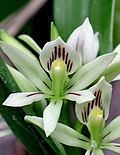 | Prosthechea abbreviata (Schltr.) W.E.Higgins (1997 publ. 1998). | Mexico, Belize, Guatemala, El Salvador, Honduras, Nicaragua, Costa Rica, Panama, Colombia, Ecuador and Peru | 100–1,400 metres (330–4,590 ft) |
| Prosthechea aemula (Lindl.) W.E.Higgins (1997 publ. 1998). | Panama, Colombia, Ecuador, Peru, Venezuela, Guyana, French Guiana, Surinam, Trinidad and Tobago and Brazil | 650–1,800 metres (2,130–5,910 ft) |
| Prosthechea alagoensis (Pabst) W.E.Higgins (1997 publ. 1998). | Brazil (Alagoas and Bahia ) | 800–1,000 metres (2,600–3,300 ft) |
| Prosthechea allemanii (Barb.Rodr.) W.E.Higgins (1997 publ. 1998). | Brazil (Minas Gerais and Parana) | 1,100–1,400 metres (3,600–4,600 ft) |
| Prosthechea allemanoides (Hoehne) W.E.Higgins (1997 publ. 1998). | Brazil ( Espirito Santo, Minas Gerais and São Paulo ) | 500–1,100 metres (1,600–3,600 ft) |
| Prosthechea aloisii (Schltr.) Dodson & Hágsater (1999). | Ecuador (Imbabura) | |
| Prosthechea arminii (Rchb.f.) Withner & P.A.Harding (2004). | Colombia and Venezuela | 1,200 metres (3,900 ft) |
 | Prosthechea baculus (Rchb.f.) W.E.Higgins (1997 publ. 1998). | Mexico (Vera Cruz, Oaxaca and Chiapas), Guatemala, Belize, Honduras, El Salvador, Nicaragua and Costa Rica and south to Colombia and Brazil | 400–1,700 metres (1,300–5,600 ft) |
| Prosthechea barbozae Pupulin (2004). | Costa Rica | 900 metres (3,000 ft) |
| Prosthechea bennettii (Christenson) W.E.Higgins (1997 publ. 1998). | Peru | 2,000–4,150 metres (6,560–13,620 ft) |
 | Prosthechea bicamerata (Rchb.f.) W.E.Higgins (1997 publ. 1998). | Mexico | 1,900–2,600 metres (6,200–8,500 ft) |
 | Prosthechea bohnkiana V.P.Castro & G.F.Carr(2004). | Brazil (Bahia) | 1,000 metres (3,300 ft) |
 | Prosthechea boothiana (Lindl.) W.E.Higgins (1997 publ. 1998). | Florida, Bahamas, Dominican Republic, Haiti, Cuba, Caymans, Mexico, Guatemala and Belize | 0–1,500 metres (0–4,921 ft) |
| Prosthechea borsiana (Campacci) Van den Berg (2015) | Peru (Amazonas) and Brazil (Goias) | |
| Prosthechea brachiata (A.Rich. & Galeotti) W.E.Higgins (1997 publ. 1998). | Mexico (Guerrero and Oaxaca) | 1,700–2,200 metres (5,600–7,200 ft) |
| Prosthechea brachychila (Lindl.) W.E.Higgins (1997 publ. 1998). | Colombia, and Venezuela | 2,000–2,700 metres (6,600–8,900 ft) |
 | Prosthechea brassavolae (Rchb.f.) W.E.Higgins (1997 publ. 1998). | Mexico Guatemala, Belize, Honduras, El Salvador, Nicaragua, Costa Rica and Panama | 900–2,500 metres (3,000–8,200 ft) |
 | Prosthechea bueraremensis (Campacci) Van den Berg(2015) | Brazil (Bahia) | 800–900 metres (2,600–3,000 ft) |
| Prosthechea bulbosa (Vell.) W.E.Higgins (1997 publ. 1998). | southeastern Brazil | 1,000–1,300 metres (3,300–4,300 ft) |
| Prosthechea caetensis (Bicalho) W.E.Higgins (1997 publ. 1998). | Brazil (Minas Gerais and Bahia) | |
 | Prosthechea calamaria (Lindl.) W.E.Higgins (1997 publ. 1998). | Colombia, Venezuela, Brazil and Bolivia | 220–1,400 metres (720–4,590 ft) |
| Prosthechea campos-portoi (Pabst) W.E.Higgins (1997 publ. 1998). | Brazil (Espirito Santo) | |
 | Prosthechea campylostalix (Rchb.f.) W.E.Higgins (1997 publ. 1998). | Guatemala, Panama and Costa Rica | 1,200–2,000 metres (3,900–6,600 ft) |
| Prosthechea carrii V.P.Castro & Campacci (2001). | Brazil (Bahia) | 1,200–1,600 metres (3,900–5,200 ft) |
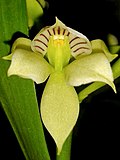 | Prosthechea chacaoensis (Rchb.f.) W.E.Higgins (1997 publ. 1998). | Mexico, Guatemala, Belize, El Salvador, Honduras Nicaragua, Costa Rica, Panama, Colombia and Venezuela | 0–1,200 metres (0–3,937 ft) |
| Prosthechea chimborazoensis (Schltr.) W.E.Higgins | Panama to Ecuador and Venezuela | |
| Prosthechea chondylobulbon (A.Rich. & Galeotti) W.E.Higgins (1997 publ. 1998). | Mexico (Nayarit, Jalisco, Colima, Michoacan, Guerrero, Mexico, Oaxaca, Vera Cruz, Puebla and Chiapas), Guatemala and El Salvador | 1,000–2,600 metres (3,300–8,500 ft) |
| Prosthechea christensonii (Harding) W.E.Higgins (2009) | Ecuador | |
| Prosthechea christyana (Rchb.f.) Garay & Withner (2001). | Bolivia | |
 | Prosthechea citrina (Lex.) W.E.Higgins(1997 publ. 1998) | Mexico | 1,300–2,600 metres (4,300–8,500 ft) |
 | Prosthechea cochleata (L.) W.E.Higgins (1997 publ. 1998). | Florida, Mexico, Guatemala, Belize, El Salvador, Honduras, Nicaragua, Costa Rica, Panama, Bahamas, Cuba, Dominican Republic, Haiti, Jamaica, Cayman Islands, Leewards, Puerto Rica, Windwards, French Guiana, Surinam, Guyana, Venezuela and Colombia | 1,900 metres (6,200 ft) |
| Prosthechea concolor (Lex.) W.E.Higgins (1997 publ. 1998). | Mexico (Jalisco, Michoacan, Mexico, Morelos, Guerrero, Oaxaca and Puebla) | 1,500–2,100 metres (4,900–6,900 ft) |
 | Prosthechea crassilabia (Poepp. & Endl.) Carnevali & I.Ramírez | Cuba, Dominican Republic, Haiti, Trinidad & Tobago, Nicaragua, Costa Rica, Panama, Colombia, Ecuador, Peru, Venezuela, Surinam, French Guiana, and Guyana | 1,200–1,900 metres (3,900–6,200 ft) |
| Prosthechea cretacea (Dressler & G.E.Pollard) W.E.Higgins (1997 publ. 1998). | Mexico (Michoacan, Mexico, Morelos, Guerrero and Oaxaca) | 2,200–2,600 metres (7,200–8,500 ft) |
| Prosthechea ebanii Chiron & V.P.Castro(2008) | Brazil ( Espirito Santo) | |
| Prosthechea elisae Chiron & V.P.Castro (2003). | Brazil (Espirito Santo) | 500 metres (1,600 ft) |
| Prosthechea faresiana (Bicalho) W.E.Higgins (1997 publ. 1998). | Brazil (Minas Gerais) | 1,000–1,500 metres (3,300–4,900 ft) |
 | Prosthechea farfanii Christenson (2002). | Peru | 2,100–2,600 metres (6,900–8,500 ft) |
| Prosthechea fausta (Rchb.f. ex Cogn.) W.E.Higgins (1997 publ. 1998). | Brazil | 700 metres (2,300 ft) |
| Prosthechea favoris (Rchb.f.) Salazar & Soto Arenas (2001). | Mexico | |
| Prosthechea fortunae (Dressler) W.E.Higgins (1997 publ. 1998). | Panama (Chiriqui) | |
 | Prosthechea fragrans (Sw.) W.E.Higgins (1997 publ. 1998). | Mexico, Guatemala, Honduras, Nicaragua, Costa Rica, Panama, Cuba, Dominican Republic, Haiti, Leewards, Trinidad & Tobago, Windwards, French Guiana, Surinam, Guyana, Venezuela, Colombia, Ecuador, Peru, Bolivia and Brazil | 2,000 metres (6,600 ft) |
| Prosthechea fuertesii (Cogn.) Christenson (2008) | Cuba to Hispaniola. | |
 | Prosthechea garciana (Garay & Dunst.) W.E.Higgins (1997 publ. 1998). | Venezuela | 1,200 metres (3,900 ft) |
| Prosthechea ghiesbreghtiana (A.Rich. & Galeotti) W.E.Higgins (1997 publ. 1998). | Mexico (Guerrero and Oaxaca) | 2,000–2,700 metres (6,600–8,900 ft) |
| Prosthechea gilbertoi (Garay) W.E.Higgins (1997 publ. 1998). | Colombia | 2,000–2,200 metres (6,600–7,200 ft) |
 | Prosthechea glauca Knowles & Westc. (1838). | Mexico, Guatemala, Honduras and El Salvador | 900–2,100 metres (3,000–6,900 ft) |
 | Prosthechea glumacea (Lindl.) W.E.Higgins (1997 publ. 1998). | Nicaragua, Guatemala, Ecuador and Brazil | 50 metres (160 ft) |
 | Prosthechea grammatoglossa (Rchb.f.) W.E.Higgins (1997 publ. 1998). | Venezuela, Colombia, Ecuador, Peru and Bolivia | 750–2,100 metres (2,460–6,890 ft) |
| Prosthechea greenwoodiana (Aguirre-Olav.) W.E.Higgins (1997 publ. 1998). | Mexico (Oaxaca) | 2,020 metres (6,630 ft) |
 | Prosthechea guttata (Schltr.) Christenson (2003). | Mexico | 1,400–2,400 metres (4,600–7,900 ft) |
| Prosthechea hajekii D.E.Benn. & Christenson (2001). | Peru ( Junin) | 1,800 metres (5,900 ft) |
| Prosthechea hartwegii (Lindl.) W.E.Higgins (1997 publ. 1998). | Venezuela, Colombia, Ecuador, Peru and Bolivia | 1,300–3,100 metres (4,300–10,200 ft) |
| Prosthechea hastata (Lindl.) W.E.Higgins (1997 publ. 1998). | Mexico (Guerrero and Oaxaca ) | 2,400 to 2,700 metres (7,900 to 8,900 ft) |
 | Prosthechea ionocentra (Rchb.f.) W.E.Higgins (1997 publ. 1998). | Costa Rica, Panama and Colombia | 900–1,600 metres (3,000–5,200 ft) |
| Prosthechea ionophlebia (Rchb.f.) W.E.Higgins (1997 publ. 1998). | Costa Rica and Panama | 700–1,100 metres (2,300–3,600 ft) |
| Prosthechea itabirinhensis (Campacci) J.M.H.Shaw | Brazil (Minas Gerais) | 1,245 metres (4,085 ft) |
| Prosthechea jauana (Carnevali & I.Ramírez) W.E.Higgins (1997 publ. 1998). | Venezuela | |
| Prosthechea joaquingarciana Pupulin (2001). | Costa Rica | 1,800–2,000 metres (5,900–6,600 ft) |
 | Prosthechea karwinskii (Mart.) J.M.H.Shaw | Mexico (Oaxaca) | 1,300–2,600 metres (4,300–8,500 ft) |
| Prosthechea kautskyi (Pabst) W.E.Higgins | Brazil (Espirito Santo ) | 500–1,200 metres (1,600–3,900 ft) |
| Prosthechea lambda (Linden ex Rchb.f.) W.E.Higgins (1997 publ. 1998). | Colombia | 200–250 metres (660–820 ft) |
| Prosthechea lindenii (Lindl.) W.E.Higgins (1997 publ. 1998). | Colombia and Venezuela | 1,600–2,000 metres (5,200–6,600 ft) |
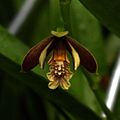 | Prosthechea livida (Lindl.) W.E.Higgins (1997 publ. 1998) | Mexico, Belize, Guatemala, El Salvador, Honduras, Nicaragua, Costa Rica, Panama, Colombia, Venezuela and Ecuador | 0–1,600 metres (0–5,249 ft) |
| Prosthechea macrothyrsodes (Rchb.f.) Christenson | Colombia | |
| Prosthechea madrensis (Schltr.) Karremans | Mexico, El Salvador and Nicaragua | 600–1,050 metres (1,970–3,440 ft) |
 | Prosthechea magnispatha (Ames, F.T.Hubb. & C.Schweinf.) W.E.Higgins (1997 publ. 1998). | Mexico | 800–1,800 metres (2,600–5,900 ft) |
 | Prosthechea marciliana (Campacci) W.E.Higgins | Brazil (Mato Grosso) | 300–400 metres (980–1,310 ft) |
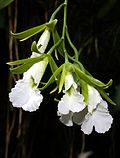 | Prosthechea mariae (Ames) W.E.Higgins | Mexico | 1,000–1,200 metres (3,300–3,900 ft) |
| Prosthechea megahybos (Schltr.) Dodson & Hágsater (1999). | Colombia, Ecuador, Peru and Bolivia | 900–1,200 metres (3,000–3,900 ft) |
| Prosthechea mejia (Withner & P.A.Harding) W.E.Higgins | Colombia | |
 | Prosthechea michuacana (Lex.) W.E.Higgins (1997 publ. 1998) | Mexico (Michoacan, Mexico, Morelos, Guerrero, Oaxaca, Hidalgo, Vera Cruz, and Chiapas ), Guatemala and Honduras | 1,500–2,800 metres (4,900–9,200 ft) |
 | Prosthechea micropus (Rchb.f.) W.E.Higgins (2005) | Mexico (Nayarit, Jaslisco, Guerrero, Mexico, Morelos, and Oaxaca ) | 1,200–2,000 metres (3,900–6,600 ft) |
 | Prosthechea moojenii (Pabst) W.E.Higgins (1997 publ. 1998). | Brazil ( Bahia and Minas Gerais) | 300 metres (980 ft) |
| Prosthechea mulasii Soto Arenas & L.Cerv. (2002 publ. 2003). | Mexico (Guerrero, Jalisco and Mexico) and Guatemala | 1,800–2,200 metres (5,900–7,200 ft) |
| Prosthechea neglecta Pupulin (2001). | Costa Rica | 1,900–2,800 metres (6,200–9,200 ft) |
 | Prosthechea neurosa (Ames) W.E.Higgins (1997 publ. 1998). | Mexico (Chiapas), Belize, Guatemala and Costa Rica | 700–1,100 metres (2,300–3,600 ft) |
| Prosthechea obpiribulbon (Hágsater) W.E.Higgins (1997 publ. 1998). | Mexico (Oaxaca to Jalisco) | 1,300–2,700 metres (4,300–8,900 ft) |
 | Prosthechea ochracea (Lindl.) W.E.Higgins (1997 publ. 1998). | Mexico, Guatemala, Honduras, El Salvador, Nicaragua, Costa Rica and Panama | 500–3,500 metres (1,600–11,500 ft) |
| Prosthechea ortizii (Dressler) W.E.Higgins (1997 publ. 1998). | Costa Rica | |
| Prosthechea pachysepala (Klotzsch) Chiron & V.P.Castro | Brazil ( Rio de Janeiro, Minas Gerais and São Paulo) | 1,000 metres (3,300 ft) |
| Prosthechea pamplonensis (Rchb.f.) W.E.Higgins (1997 publ. 1998). | Venezuela and Ecuador | 1,800–2,700 metres (5,900–8,900 ft) |
| Prosthechea panthera (Rchb.f.) W.E.Higgins (1997 publ. 1998). | Mexico(Oaxaca and Chiapas) and Guatemala | 1,300–2,100 metres (4,300–6,900 ft) |
| Prosthechea papilio (Vell.) W.E.Higgins (1997 publ. 1998). | Brazil (Espirito Santo, Minas Gerais near Serra da Canastra, Rio de Janeiro, Rio Grande do Sul and Santa Catalina) | |
| Prosthechea pastoris (Lex.) Espejo & López-Ferr. (2000). | Mexico | 100–2,500 metres (330–8,200 ft) |
| Prosthechea pitengoensis (T.V.S.Campacci & Laitano) J.M.H.Shaw | Brasil (Minas Geraias) | 600 metres (2,000 ft) |
| Prosthechea pringlei (Rolfe) W.E.Higgins (1997 publ. 1998). | Mexico (Michoacan, Mexico, Morelos, Guerrero and Oaxaca ) | 1,800–2,500 metres (5,900–8,200 ft) |
 | Prosthechea prismatocarpa (Rchb.f.) W.E.Higgins (1997 publ. 1998). | Costa Rica and Panama | 1,200–3,300 metres (3,900–10,800 ft) |
 | Prosthechea pseudopygmaea (Finet) W.E.Higgins | Mexico, Guatemala, El Salvador, Honduras, Costa Rica and Panama | 1,400–2,700 metres (4,600–8,900 ft) |
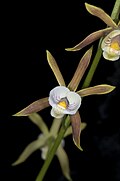 | Prosthechea pterocarpa (Lindl.) W.E.Higgins (1997 publ. 1998). | Mexico | 550–2,200 metres (1,800–7,220 ft) |
| Prosthechea pulcherrima (Klotzsch) W.E.Higgins (1997 publ. 1998). | Peru | |
| Prosthechea pulchra Dodson & W.E.Higgins (2001). | Ecuador and Bolivia | 2,600 metres (8,500 ft) |
 | Prosthechea punctulata (Rchb.f.) Soto Arenas & Salazar | Mexico (Sinaloa, Jalisco, Michoacan, Mexico, Morelos, Guerrero) | 1,500–2,300 metres (4,900–7,500 ft) |
| Prosthechea pygmaea (Hook.) W.E.Higgins (1997 publ. 1998). | Florida, Cuba, Dominican Republic, Haiti, Jamaica, Leewards?, Puerto Rico, Trinidad & Tobago, Windwards, Mexico, Guatemala, Belize, Honduras, Nicaragua, Costa Rica, Panama, French Guiana, Surinam, Guyana, Venezuela, Colombia, Ecuador, Peru, Bolivia and Brazil | 0–1,700 metres (0–5,577 ft) |
| Prosthechea racemifera (Dressler) W.E.Higgins (1997 publ. 1998). | Costa Rica and Panama | 600–1,500 metres (2,000–4,900 ft) |
 | Prosthechea radiata (Lindl.) W.E.Higgins (1997 publ. 1998). | Mexico (San Luis Potosí, Querétaro Hidalgo, Puebla, Veracruz, Oaxaca, Tabasco and Chiapas), Guatemala, Honduras and Belize to Costa Rica, Panama, Colombia | 150–2,000 metres (490–6,560 ft) |
| Prosthechea regentii V.P.Castro & Chiron | Brazil (Minas Gerais) | 500–700 metres (1,600–2,300 ft) |
| Prosthechea regnelliana (Hoehne & Schltr.) W.E.Higgins (1997 publ. 1998). | Brazil (Minas Gerais) | |
| Prosthechea rhynchophora (A.Rich. & Galeotti) W.E.Higgins (1997 publ. 1998). | Mexico, Guatemala, Honduras and Nicaragua | 950–2,000 metres (3,120–6,560 ft) |
| Prosthechea roraimensis V.P.Castro & Campacci | Brazil (Roraima) | 600–1,000 metres (2,000–3,300 ft) |
 | Prosthechea sceptra (Lindl.) W.E.Higgins (1997 publ. 1998). | Venezuela, Colombia and Ecuador | 150–2,000 metres (490–6,560 ft) |
| Prosthechea schunkiana (Campacci & P.A.Harding) W.E.Higgins | Brazil (Minas Gerais) | 600 metres (2,000 ft) |
| Prosthechea semiaperta (Hágsater) W.E.Higgins | Mexico (Guerrero and Oaxaca ) | 500–2,500 metres (1,600–8,200 ft) |
| Prosthechea serpentilingua Withner & D.G.Hunt | Brazil | |
| Prosthechea sessiliflora (Edwall) W.E.Higgins (1997 publ. 1998). | Brazil (São Paulo and Minas Gerais) | |
| Prosthechea silvana Cath. & V.P.Castro (2003). | Brazil (Bahia) | 400–800 metres (1,300–2,600 ft) |
| Prosthechea sima (Dressler) W.E.Higgins (1997 publ. 1998). | Panama and Colombia | 600–1,400 metres (2,000–4,600 ft) |
| Prosthechea spondiada (Rchb.f.) W.E.Higgins (1997 publ. 1998). | Costa Rica, Jamaica, and Panama | 900–2,100 metres (3,000–6,900 ft) |
| Prosthechea squalida (Lex.) Soto Arenas & Salazar | Mexico (Nayarit, Jalisco, Coloma, Michoacan, Guerrerro, Mexico, Moreles, Oaxaca and Vera Cruz) | 500–2,300 metres (1,600–7,500 ft) |
| Prosthechea suzanensis (Hoehne) W.E.Higgins (1997 publ. 1998). | Brazil (Minas Gerais, São Paulo) | |
| Prosthechea tardiflora Mora-Ret. ex Pupulin (2001). | Costa Rica | 500–600 metres (1,600–2,000 ft) |
 | Prosthechea terassaniana (Campacci & P.A.Harding) W.E.Higgins | Brazil (São Paulo) | 200–300 metres (660–980 ft) |
| Prosthechea tigrina (Linden ex Lindl.) W.E.Higgins (1997 publ. 1998). | Brazil, Colombia, Ecuador, Peru, Venezuela and the Guianas | 2,100–2,700 metres (6,900–8,900 ft) |
| Prosthechea tinukiana Bogarín & Karremans | Costa Rica | 2,450 metres (8,040 ft) |
 | Prosthechea trulla (Rchb.f.) W.E.Higgins (1997 publ. 1998). | Mexico | 300–1,500 metres (980–4,920 ft) |
| Prosthechea vagans (Ames) W.E.Higgins (1997 publ. 1998). | Mexico, Guatemala, El Salvador, and Costa Rica | 1,400–1,950 metres (4,590–6,400 ft) |
| Prosthechea varicosa (Bateman ex Lindl.) W.E.Higgins (1997 publ. 1998). | Mexico (Jalisco, Michoacan, Guerrero, Morelos, Oaxaca, Vera Cruz, Puebla, and Hidalgo) | 1,500–2,800 metres (4,900–9,200 ft) |
| Prosthechea vasquezii Christenson (2003). | Bolivia. | |
| Prosthechea venezuelana (Schltr.) W.E.Higgins (1997 publ. 1998). | Venezuela, Colombia and Ecuador | 450 metres (1,480 ft) |
| Prosthechea vespa (Vell.) W.E.Higgins (1997 publ. 1998). | Brazil | 15–1,000 metres (49–3,281 ft) |
| Prosthechea villae-rosae P.Ortiz | Colombia (Cundinamarca) | 2,800 metres (9,200 ft) |
 | Prosthechea vita (D.G.Hunt, Withner & P.A.Harding) J.M.H.Shaw | Ecuador | |
 | Prosthechea vitellina (Lindl.) W.E.Higgins (1997 publ. 1998). | Mexico, Nicaragua and Honduras | 1,400–2,600 metres (4,600–8,500 ft) |
| Prosthechea widgrenii (Lindl.) W.E.Higgins (1997 publ. 1998). | Brazil (Minas Gerais) | 500–1,000 metres (1,600–3,300 ft) |
|









































